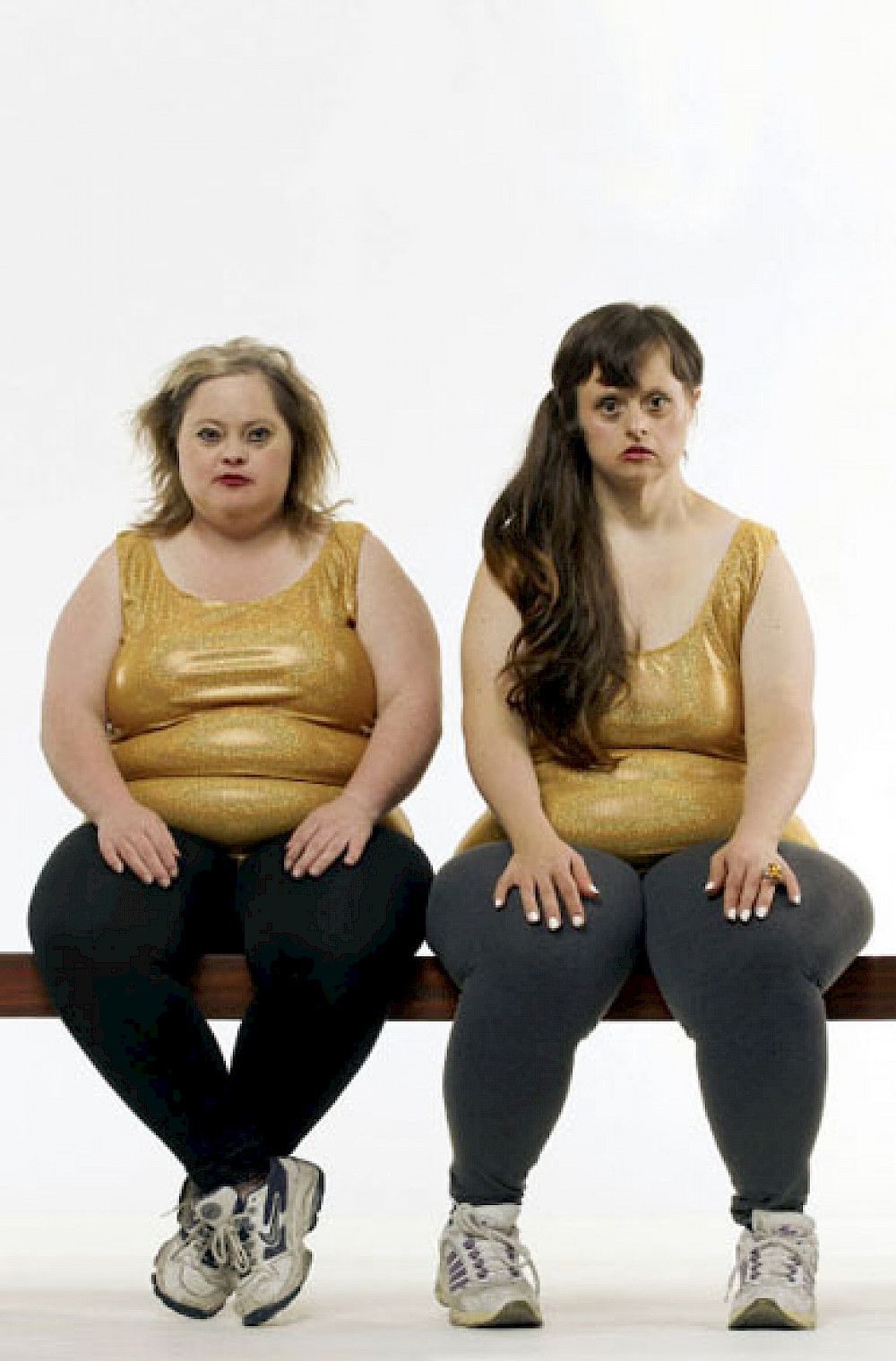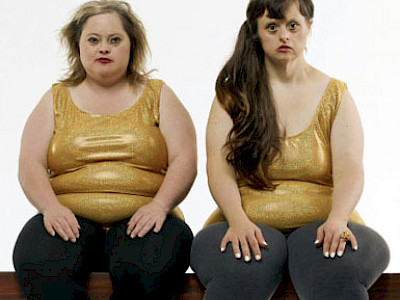02 — 05.05.2009
The core actors in the Australian Back to Back Theatre company are people with a mental disability. On the basis of their “difference”, they offer an individual view of the social, ethical and cultural patterns created by the “majority”. In Food Court , a young woman is utterly and brutally victimised, to the tones of live improvisation by the Australian cult group The Necks. Two actresses, with the air of stars and dressed in brightly coloured leotards – which immediately undermine the ideal of classical beauty – frolic across the stage. With immense pleasure, they abandon themselves to the humiliation of a third young woman. A situation of merciless cruelty, from which a fragile and moving beauty astonishingly wells up. Food Court was the great discovery at the last Melbourne Festival. It displays great visual and musical virtuosity, and at the same time harks back to the essence of theatre.
Back to Back Theatre with The Necks – Food Court
John Bailey, April 2009
For many Australian audiences – and I suspect this holds true internationally as well – there is a perception of theatre dealing with disability as “worthy”; that is, as having an intrinsic value that precedes the merit of the actual work done. This is true, to an extent. Companies such as Back to Back provide employment to people whose career options may be more limited than most, and expression to those who often go unrepresented in other media. But that label – “worthy” – can also be a scornful one, suggesting that the artistic value of these works is secondary, even by implication second-rate.
Anyone who has actually witnessed one of Back to Back Theatre’s productions, or those of a number of other leading Australian companies working with people with disabilities, will lose this poisonous sense of superiority in an instant. Food Court and previous works such as small metal objects and Soft have proven that Back to Back deserves to be ranked alongside the world’s most innovative creators of performance, the likes of the UK’s Forced Entertainment, France’s Theatre du Soleil and Italy’s Societas Raffaello Sanzio.
This is not to downplay or ignore the disabilities of Back to Back’s ensemble, however – quite the opposite. The company’s strength is precisely in the way it engages an audience’s perception of disability to create works that challenge and upset our very understanding of performance itself. Confronting, witty, reflexive and always compelling, these are experiences that pull back the curtain to reveal the hidden lines of power that operate in any relationship between a performer and their audience.
And power is the true subject of Food Court, which deals with vulnerability, nakedness, oppression and violence. We watch as two women victimise a silent third in a suburban mall before leading her into a forest of dark and threatening shadows, sinister figures and no safe refuge. The relentless horror of this bullying is made all the more potent by the reality of the figures who play out the tragedy, themselves visibly “other”. For a non-disabled audience, the question thrown in our faces is: who is the real bully here, and who is the victim?
The work is overtly about power and its abuses, but much of its effectiveness comes from the power its performers exert over a helpless audience. This is a level at which Food Court itself engages in a dialogue with the history of the theatre itself – a history which for more than a century has seen the social role of theatre increasingly reduced to the passive, solitary experience of sitting silently in the dark, applauding on cue, keeping silent when expected. This is theatre’s comfort – as a space to safely explore ideas and emotions without having to actively collude in their expression.
Food Court is a work that cannot help but unsettle, even disturb its audience, but during its development the performers who enact these scenes of violence and brutality described it as a strangely satisfying process. Like an exorcism, the demons they unleash upon the stage are brought up from deep within, but have their origins beyond the individual, stemming from something more social, more communal, perhaps even universal.
The process of creation behind Food Court reflects this complexity. Collaboration is integral to the company’s practice – the core ensemble regularly engages with other artists during the development process, and no work can be seen as the result of a single aesthetic vision. The notion of the solitary artistic genius – the auteur, the prima donna, the virtuoso – is perhaps an irrelevant, dusty relic from an earlier age in a contemporary climate of diverse cross-pollination and international exchange. Certainly, Back to Back’s collaborative stance produces a variety of voices that constantly expand each work’s significance. Touring, too, is a component here: productions take on new resonances, grow and deepen in response to the environments in which they unfold across the globe.
An obvious example of this hybrid nature is Food Court’s inclusion of a haunting live score by The Necks, one of Australia’s leading producers of experimental, improvisational music that defies easy categorisation. The music is inseparable from the work’s overall effect of uncertainty and ethereal, lingering beauty, but it is also a truly spontaneous and live performance that itself becomes one of Food Court’s main players. The musicians respond sonically to the different energies and rhythms of the onstage actors, whose own interpretations of the moment shift subtly as a result. This cyclic process ensures that no two performances of Food Court will be alike.
This was true of Back to Back’s previous, highly acclaimed production small metal objects. When it first appeared in Australia, it was staged on the main concourse of a busy train station at rush hour, the audience seated facing a mass of hurrying commuters, ambling tourists and shop vendors. The actors wore hidden microphones which conveyed their words to earphones worn by the audience, but their anonymous status meant that for the mass of passing faces, it was the audience itself that formed an object of confused curiosity. As an urgent drama played out for our eyes only, we were simultaneously aware of ourselves as the object of unwanted scrutiny by strangers, some of whom became part of the spectacle by approaching the seating block.
Food Court is the first Back to Back work in some time to be staged within a conventional theatre, so it is not surprising that it builds upon this interrogation of the dynamics between audience and performer, self and other. Food Court premiered at the Melbourne International Arts Festival, but I first saw it in the company’s hometown of Geelong. Barely an hour’s drive separates the two cities, but Geelong is often the victim of its bigger sibling’s own prejudices and self-doubts. Melbourne constantly promotes itself as a cosmopolitan city of culture and art, while looking at Geelong as a more parochial, underdeveloped town. The truth is, of course, more complex. That Geelong could have spawned a company such as Back to Back, which frequently proves itself more fascinating and dynamic than any of Melbourne’s own performing companies, is testament to the fact that one’s perception of another is always weighed down by the unwanted baggage we force them to carry.
It’s only fitting that digital projection takes such a central role in the aesthetic of Food Court, since so much of the work’s murky ambiguity toys with the meanings we project upon it. Just as the histories and memories of those behind its creation are littered with the assumptions and expectations others have placed upon them, so too does the significance of Food Court’s dark vision cause us turn an eye towards our own prejudices, fears and unconscious longings. The shifting woodscape in which much of the action occurs could well be a potent metaphor for the crowded and anxious interior landscape of our own minds where, perhaps, we are never truly alone. I hope that your experience of Food Court is as powerful as that which I had in Geelong. Yours will be a different encounter, given the geographic and cultural distance between these productions. But as Food Court so sublimely illustrates, that distance is no farther – or closer – than the space you maintain from the person next to you right now, in this theatre, in this forest, in this life.
Text, Direction & Set Design
Bruce Gladwin
Text & Performance
Mark Deans, Rita Halabarec, Nicki Holland, Sarah Mainwaring, Scott Price
Music
The Necks - Chris Abrahams (Piano), Tony Buck (Drums), Lloyd Swanton (Bass)
Set Design & Construction
Mark Cuthbertson
Lighting Design & Technical Direction
Andrew Livingston, bluebottle
Animated Design
Rhian Hinkley
Sound Design
Hugh Covill
Costumes
Shio Otani
Presentation
KVS, Kunstenfestivaldesarts
Production
Back to Back Theatre
Supported by
The Australia Council for the Arts & Arts Victoria
Thanks to
Melbourne International Arts Festival


